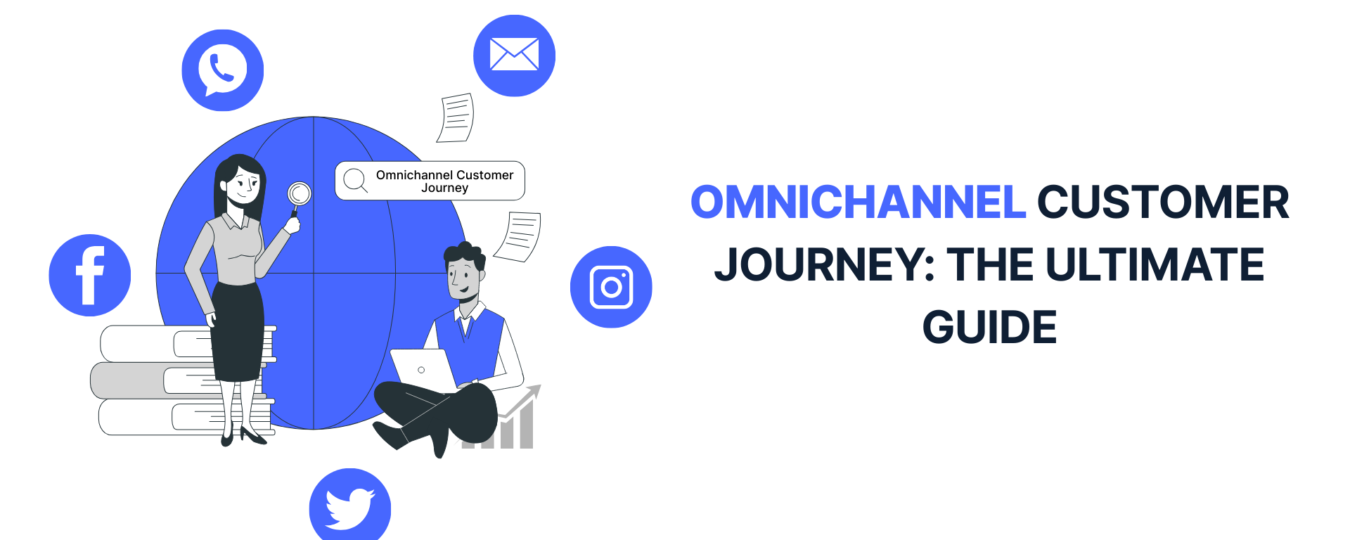The modern customer journey doesn’t follow a straight line anymore. It moves across platforms, channels, and even devices—often within minutes. A user might browse your product on mobile during lunch, switch to desktop in the evening, and later ask a question on social media. All of this makes the omnichannel customer journey one of the most important strategies for customer experience today.
This guide will walk you through what an omnichannel journey is, why it’s essential, how it works, and how you can design one that actually delivers value to both your customers and your business.
What is the Omnichannel Customer Journey?
The omnichannel customer journey refers to a fully connected and consistent customer experience across all the channels your brand uses—online and offline. The goal is to create a seamless flow where customers don’t feel like they’re starting over every time they switch platforms.
For example, someone might see an Instagram ad, visit your website to explore the product, chat with a support agent for more details, and then complete the purchase in-store or through a mobile app. Throughout this journey, their context, history, and preferences should carry over without any interruption. That’s the essence of an effective omnichannel strategy—making every interaction feel like a continuation of the last, regardless of the platform.
Why is Omnichannel So Important in Today’s Market?
Customers today expect more than just accessibility—they expect continuity. They want brands to understand who they are, what they’ve done, and what they need next—without having to repeat themselves.
1. Customer Expectations Are Higher Than Ever
People don’t just want to interact with your brand—they want it to feel effortless. Whether it’s an email, a social media DM, a website visit, or an in-store interaction, they expect every channel to be connected. Disconnected experiences lead to confusion and frustration, which often result in lost sales.
2. Retention Comes from Consistency
When a customer enjoys a smooth experience across all touchpoints, they’re more likely to return. A consistent journey shows that your brand values their time and understands their preferences, which builds long-term loyalty.
3. Better Data = Smarter Business
Omnichannel journeys allow you to collect better insights into customer behavior. With connected tools, businesses can track interactions, analyze patterns, and personalize experiences in a much more informed way—leading to higher engagement and better ROI.
The 5 Key Stages of the Omnichannel Customer Journey
To improve your customer journey, it’s important to understand how users typically move through it. Let’s look at the five major stages.
1. Awareness
This is the moment when the customer first learns about your brand. It could happen through a Google search, a social media ad, a friend’s recommendation, or a blog post. The key here is visibility and brand recognition.
At this stage, your job is to make sure the message you’re putting out is consistent across all the platforms you’re using. Whether a customer sees you on Instagram or finds you on LinkedIn, they should understand what your brand stands for right away.
2. Consideration
Once a customer becomes aware of your product or service, they move into research mode. They’ll likely compare your offering to others, read reviews, ask questions, and check product features. They may engage with your brand on different channels—like email, your website, or live chat.
During this stage, your goal is to help them make a decision by giving them all the information they need, in a personalized and timely way. This could be through automated follow-ups, informative content, or direct interaction with your support team.
3. Purchase Decision
Now the customer is ready to buy—but they still want the process to be easy, smooth, and trustworthy. Any friction here—like a complicated checkout process, lack of payment options, or poor mobile performance—can cause drop-offs.
To make this stage work, ensure your purchase journey works seamlessly across all devices and channels. Cart details should carry from mobile to desktop. Payment and shipping information should auto-fill if the customer is logged in. And if they switch to a physical store, the staff should be able to access their preferences or order history.
4. Post-Purchase Support
The journey doesn’t end once the transaction is complete. This is the phase where many brands either strengthen or lose customer trust. Whether it’s providing tracking information, handling returns, or offering usage support, your post-purchase experience matters.
It’s important that your customer can reach you easily—whether through email, live chat, phone, or messaging apps. But beyond that, they should get consistent responses. Agents on different platforms should have access to the same customer data to avoid repetition and delays.
5. Loyalty and Advocacy
If the experience was smooth, customers are more likely to return and recommend you to others. This is where real value is built—not just from the initial sale, but from long-term engagement.
Encourage repeat business through personalized emails, exclusive discounts, early access to new products, or referral incentives. When customers feel appreciated, they naturally become brand advocates.
How to Build a Strong Omnichannel Strategy
Delivering a successful omnichannel journey doesn’t happen overnight. It takes planning, coordination, and the right tools. Here’s how to get started:
1. Identify and Map Customer Touchpoints
Understand where your customers interact with your brand. Create a journey map that outlines all possible entry and exit points—social media, search, website, app, store, email, etc. This helps you visualize their path and identify where you may need to improve the experience.
2. Use Technology That Connects Channels
Your CRM, email marketing, customer support, and analytics platforms need to work together. Invest in tools that sync data between systems, so that each team has access to the same customer profile.
This avoids duplicated efforts and makes sure that whether a customer contacts sales or support, they get relevant, personalized service.
3. Train Teams for a Unified Approach
Even the best tools are ineffective if your teams aren’t aligned. Ensure that marketing, sales, and support teams all understand the customer journey and how to handle each touchpoint. Regular training helps maintain consistency in communication and service.
4. Personalize Every Interaction
Use the data you collect to make each customer feel seen. Recommend products based on past purchases. Send reminder emails if someone abandons their cart. Offer customer support that references their previous issues. Personalization makes the experience feel thoughtful instead of automated.
5. Continuously Measure and Improve
Track metrics like customer satisfaction (CSAT), first contact resolution (FCR), average response time, and retention rate. These numbers will show you what’s working and where there’s room for improvement.
Run journey audits regularly and look at drop-off points. Improving even one small area of friction can lead to significant gains in conversion and loyalty.
Final Thoughts
The omnichannel customer journey is not just about being present on different platforms—it’s about making sure the entire experience feels connected and effortless for your customers. Whether someone starts on your website, switches to your mobile app, or later speaks with your support team, the transition should be smooth and consistent.
When every touchpoint feels like part of one ongoing conversation, customers feel valued and understood. That level of ease and continuity builds trust, improves satisfaction, and encourages loyalty. Creating such a journey requires the right tools, a clear understanding of your customer behavior, and a commitment to improving over time. In the end, it’s the brands that focus on delivering a thoughtful and connected experience that truly stand out and keep their customers coming back.
Frequently Asked Questions (FAQs)
1. What is the difference between multichannel and omnichannel customer journeys?
While both involve interacting with customers across multiple platforms, the key difference is integration. A multichannel journey uses various channels like social media, email, and websites, but they often work in silos. An omnichannel journey, on the other hand, connects these channels so the customer has a smooth, consistent experience without repeating information.
2. Why is an omnichannel customer journey important for business growth?
An effective omnichannel strategy builds trust, satisfaction, and loyalty by making the customer experience feel natural and uninterrupted. When customers can move between platforms without confusion or frustration, they’re more likely to complete purchases, return for future interactions, and recommend your brand to others.
3. What tools are needed to create an omnichannel experience?
You’ll need tools that allow your systems to talk to each other. This includes a CRM system for managing customer data, marketing automation tools for personalized communication, customer service platforms that support multiple channels, and analytics tools to track customer behavior across all touchpoints.
4. How can small businesses implement an omnichannel strategy?
Start with the channels that matter most to your audience—maybe a website, email, and WhatsApp—and make sure they’re consistent and connected. Use platforms that offer built-in integrations, focus on clear communication, and gradually expand to more channels as your customer base grows.
5. How do you measure the success of an omnichannel customer journey?
Success can be measured through metrics like customer satisfaction scores (CSAT), customer retention rate, average response time, and conversion rates across channels. Regularly tracking these metrics will help you identify what’s working and where you can improve the experience.




